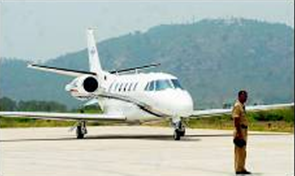Airports: India
(→Infrastructure) |
(→International Airports) |
||
| Line 105: | Line 105: | ||
[https://epaper.timesgroup.com/Olive/ODN/TimesOfIndia/shared/ShowArticle.aspx?doc=TOIDEL%2F2018%2F10%2F02&entity=Ar00907&sk=46CFF802&mode=text Jasjeev Gandhiok, IGI preferred gateway to India, October 2, 2018: ''The Times of India''] | [https://epaper.timesgroup.com/Olive/ODN/TimesOfIndia/shared/ShowArticle.aspx?doc=TOIDEL%2F2018%2F10%2F02&entity=Ar00907&sk=46CFF802&mode=text Jasjeev Gandhiok, IGI preferred gateway to India, October 2, 2018: ''The Times of India''] | ||
| + | [[File: 2018- Top 15 airports for foreigners availing an e-Tourist Visa for the country.jpg|2018- Top 15 airports for foreigners availing an e-Tourist Visa for the country <br/> From: [https://epaper.timesgroup.com/Olive/ODN/TimesOfIndia/shared/ShowArticle.aspx?doc=TOIDEL%2F2018%2F10%2F02&entity=Ar00907&sk=46CFF802&mode=text Jasjeev Gandhiok, IGI preferred gateway to India, October 2, 2018: ''The Times of India'']|frame|500px]] | ||
The Indira Gandhi International Airport continues to be foreign travellers’ most preferred gateway into India — accounting for almost 50% of the total number of passengers entering the country. According to the latest International Air Transport Association (IATA)-IS Data for September 2018, Delhi alone accounts for nearly 46% of the foreign tourists who entered the country and took an e-Tourist Visa (E-TV) — almost three times more than the next destination, which is Mumbai (16.8%). | The Indira Gandhi International Airport continues to be foreign travellers’ most preferred gateway into India — accounting for almost 50% of the total number of passengers entering the country. According to the latest International Air Transport Association (IATA)-IS Data for September 2018, Delhi alone accounts for nearly 46% of the foreign tourists who entered the country and took an e-Tourist Visa (E-TV) — almost three times more than the next destination, which is Mumbai (16.8%). | ||
Revision as of 22:51, 7 October 2018
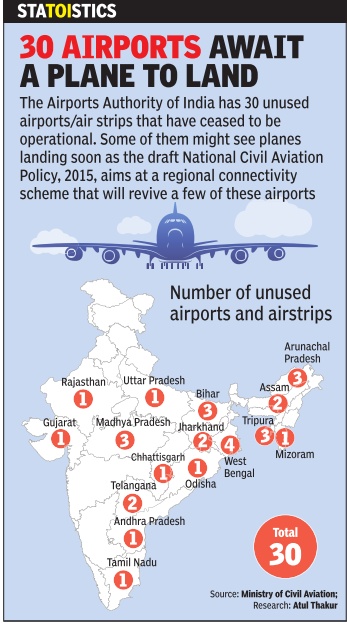
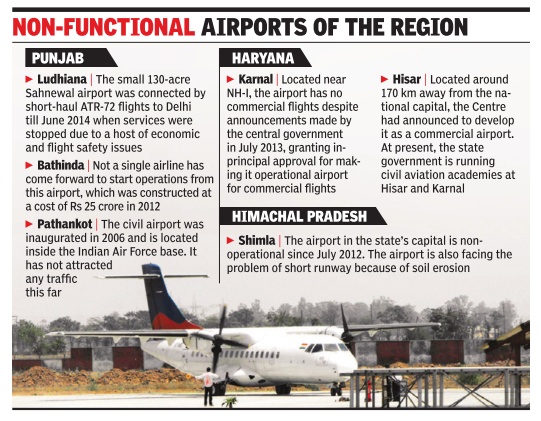
This is a collection of articles archived for the excellence of their content. Readers will be able to edit existing articles and post new articles directly |
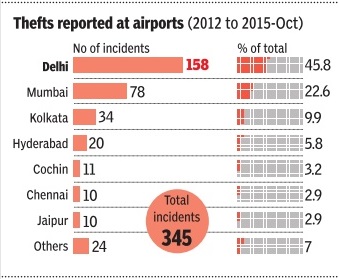
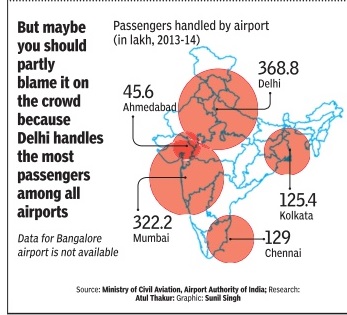
Capacity of airports
2017/ Delhi, Mumbai reach saturation point
Saurabh Sinha, Delhi airport ops below potential, The Times of India, March 17, 2017
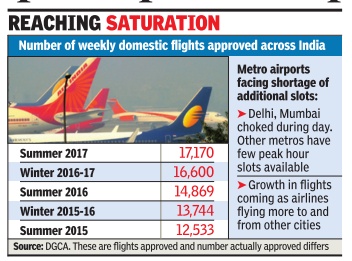
Indians may be flying like never before but the infrastructure crunch at metro airports is limiting their choice of flights. The problem is so acute that putting an additional flight during peak hours is becoming tough at most metros. Delhi airport, for instance, will not be adding a single flight between 7am and 10pm this summer.
Airlines are pleading with Mumbai airport authorities to allow more domestic flights at night as the airport has no additional day slots left. These two airports accounted for almost 10 crore of the total (domestic and international) passenger traffic of over 15 crore last year. The severe infrastructure crunch at major Indian airports was highlighted during recent deliberations aviation authorities held with airlines to finalise the summer schedule this year. The Directorate General of Civil Aviation (DGCA) cleared a summer schedule of 17,170 domestic flights a week from 77 airports by 12 airlines.
TOI accessed the minutes of the meeting, prepared by the Airports Authority of India (AAI), which reveals that big airports are bursting at the seams. So much so that airlines have ordered hundreds of planes but no one knows where they will be parked.
The Delhi airport's representative said at the meeting that “no new flights are being accepted from 7am to 10pm as Delhi airport is full during that period“. Delhi is the only airport in India that has three runways but due to airside infrastructure crunch, the hourly aircraft movement remains way below potential.
The minutes say that while the maximum hourly capacity of IGI Airport's three runways is 75 aircraft (70 schedule and 5 non-schedule), the “practical hourly capacity to be considered for allocation of slots“ is much less at 67 (62 schedule and 5 non-schedule). A reduction of eight schedule flights means 192 fewer flights a day .
With two IGI runways (when one is closed for repairs), the hourly capacity is between 45 and 60. Also between 11pm and 6am, it can handle a maximum of 45 flights an hour due to special runway usage procedure to cut on night-time noise from planes The Mumbai airport representative admitted that his was a “constrained airport“. On its part, AAI admitted that the “runway capacity (aircraft handling) of airports is the same as the past season“.
Airlines are seething as they had been ordering planes but the big airports don't have slots for additional flights or even adequate parking stands.
According to the minutes, Neville Mehta of Jet Airways said: “There needs to be a way forward to increase air traffic movement at metros especially Delhi and Bengaluru... given the status of airport infrastructure almost across the country and with no immediate solution in sight, airlines have no room to either expand or manoeuvre their schedulesnetwork commensurate with passenger growth.“
The minutes quote Debashis Saha of SpiceJet saying: “There has been no increase in runway capacity at major airports. Delhi remains a major concern with just 62 movements an hour and both AAI and DIAL (Delhi International Airport Pvt Ltd) have indicated no new slots at Delhi Airport between 7am and 10pm.Mumbai continues to remain capacitated and Chennai, Kolkata, Bengaluru are also capacitated in peak hours. There is a real capacity constraint in Mumbai... to procure slots, MIAL (Mumbai International Airport Pvt Ltd ) should look into allowing domestic airlines on regular basis to operate late night flights.
2017/ Measure to deal with saturation
Saurabh Sinha, More red-eye flights on cards as airports choke, October 26, 2017: The Times of India
See graphic:
Indian Airports and the year when they will reach their saturation point
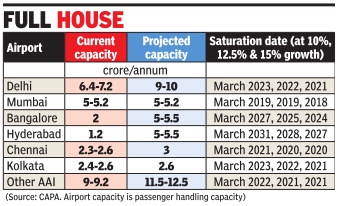
From: Saurabh Sinha, More red-eye flights on cards as airports choke, October 26, 2017: The Times of India
Airlines Warned Of Penalty For Unused Slots
India may be the world's fastest growing aviation market but its crippling airport infrastructure crunch is now threatening this growth story. TOI has accessed the minutes of the meeting held between airlines and aviation authorities to finalise the winter flight schedule. Only three airports -Chennai, Bengaluru and Trivandrum -can handle four more flights an hour this winter while all other big airports remain choked in terms of runway capacity . The aviation ministry is asking airlines to shift some flights to red-eye hours (prior to 5 am) to make space for regional slots.
Aviation authorities have approved 18,860 weekly domes tic flights from 90 airports for winter 2017-18. The crunch at big airports is leading to alarm bells ringing with airport operators now threatening to act tough on airlines that do not actually operate the precious slots given to them by taking them away and giving them to some one else who will actually operate a flight at that time.
In a possible first, the Airports Authority of India has “proposed financial penalty for slot misuse by airlines“. Private airport operators also said airlines must adhere to slots and give up those which they are not operating so that someone else can fly at the time.
However, SpiceJet's Debashish Saha and Jet Airways' Neville Z Mehtaare quoted by the minutes as saying: “ As requested by Mumbai Airport, displacing existing slots for flights at metros to accommodate RCC flights (including for airlines yet to commence operations) would not be commercially viable and the need of the hour is in fact to increase runway capacity to accommodate RCS (regional connectivity scheme) flights.“
Infrastructure
2018: terminals, runways haven’t kept pace with fast growing traffic
May 1, 2018: The Times of India
Reporting by Saurabh Sinha in Delhi, Manju V in Mumbai, Subhro Niyogi in Kolkata, Shoeb Khan in Jaipur and Sudipta Sengupta in Hyderabad
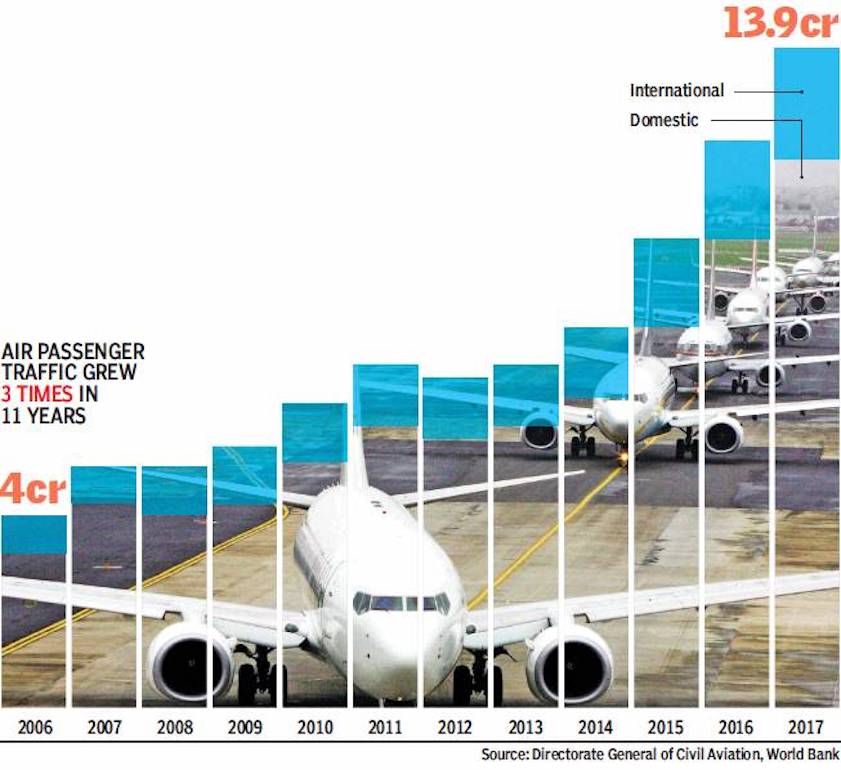
From: May 1, 2018: The Times of India

From: May 1, 2018: The Times of India
In April 2018, the tyres on an Indigo flight from Tirupati to Hyderabad burst on touchdown — leading to thousands of passengers being stranded in airports across the country for up to seven hours. Every day, though, delays of half an hour or more, which have a cascading effect on schedules country-wide, are par for the course — a result of soaring passenger traffic, and stagnation in planning and expansion of airports to handle the footfalls.
Airports in India — from the busiest like Delhi and Mumbai to smaller ones in Patna and Guwahati — have become synonymous with queues, delays and congestion. On the airside, failure to add runways and parking bays has meant airports are unable to clear airlines’ requests to add more flights.
“If a flight gets delayed at another city like Delhi or Mumbai, there are delays in all the other sectors. This is beyond our control,” said an airline official. In December, for instance, 45% of flights were delayed at Mumbai.
India has recorded double-digit growth in domestic air passenger traffic for the past 42 months, shows data from International Air Transport Association (IATA), a trade body of global airlines. Passenger traffic at Delhi airport grew 14% in 2017 compared to the previous year, making it the fastest growing airport in the world, according to Centre for Asia Pacific Aviation (CAPA), a global consultancy firm.
It’s the same across the country. Hyderabad airport was meant to handle 12 million passengers per annum, but footfalls crossed 18 million in 2017. Last year, Kolkata’s Netaji Subhas Chandra Bose International Airport handled 19.5 million passengers — the terminal can manage 20 million passengers and will run out of space this year. Even at Patna airport, passenger traffic hit 29 lakh last year — a 48% increase over 2016 numbers — when the airport can handle just 7 lakh passengers a year.
Prakash Singh avoids flying in or out of Patna on holidays. “The queue to enter the airport can stretch into the car park,” he said. “There are two baggage scanners, which means you spend a long time completing security check. The airport is the same as it was 20 years ago though the number of flights has shot up. Patna airport can give a bus stand a run for its money,” said Singh, who lives in Noida and travels to his hometown frequently.
Mumbai, India’s second busiest airport, does not feature among the world’s top 20 fastest growing airports. It’s telling because till 2012, Mumbai was the busiest airport in India. “Infrastructure shortages played a critical role in this displacement,” said Kapil Kaul of CAPA. Air travel growth out of Mumbai will remain the same till a second airport comes up.
Airport capacity is measured by two parameters: passenger handling capacity of its terminal buildings and air traffic handling capacity of its runways. And both are in jeopardy at most airports. Last September, Central Industrial Security Force (CISF) — responsible for passenger and bag checks — sounded a warning about adding more flights without infrastructure. “Total passenger traffic at all airports has increased by 65% in the last five years… Despite this huge increase, security infrastructure and manpower have remained the same, resulting in congestion and undue pressure on security personnel for speedy clearance,” CISF told the government. “Our airports may turn unmanageable… Planning has to be proactive and futuristic rather than reactive,” it added.
Delhi and Mumbai now deny slots to airlines to add flights as the airports are at capacity. Indian airline companies have ordered 900 aircraft but have nowhere to park.
An aviation ministry official said: “Air traffic has grown faster than the rate at which infrastructure is being added. There is a temporary mismatch. We are working on it. Delhi, Mumbai, Pune, Patna and Goa will get second airports in the next three to five years.”
An Airports Authority of India official said: “AAI will construct 273 aircraft parking bays for A321 aircraft in next five years. State governments have been requested to provide additional land.”
But experts say the facilities should have been operational by now. IATA India recently said: “IATA anticipates India will be the third largest aviation market by 2024. To make this a reality, airport capacity needs to be augmented.”
AAI says the overall terminal capacity is 33.4 crore passengers per annum against a demand of 30 crore. “As per our own forecast, the country would need to construct an additional capacity of 50 crore by 2030,” said a senior official.
International Airports
2018: The top 15
Jasjeev Gandhiok, IGI preferred gateway to India, October 2, 2018: The Times of India

From: Jasjeev Gandhiok, IGI preferred gateway to India, October 2, 2018: The Times of India
The Indira Gandhi International Airport continues to be foreign travellers’ most preferred gateway into India — accounting for almost 50% of the total number of passengers entering the country. According to the latest International Air Transport Association (IATA)-IS Data for September 2018, Delhi alone accounts for nearly 46% of the foreign tourists who entered the country and took an e-Tourist Visa (E-TV) — almost three times more than the next destination, which is Mumbai (16.8%).
Among other airports attracting foreign tourists are the Dabolim Airport in Goa (9.5%), the Chennai Airport (5.8%) and the Bengaluru airport (5.2%). Delhi airport, at present, handles 64 airlines, 53 of which are foreign carriers. It also connects 141 destinations, of which 73 are international locations.
“Over a period of time, the Delhi airport has been able to expand its network globally. The airport has been closely working with all Indian as well as foreign carriers to expand its reach all across the globe and has been successfully able to establish Delhi as a true gateway to India. It is the India’s largest and busiest airport, both in terms of passenger and cargo movement,” a DIAL spokesperson said.
As per the IATA report, Delhi alone offers 27% of the total international departing seats from India and close to 40% of the total international departing seats from the six metro cities of India.
Similarly, Delhi offers 20% of all departing domestic seats within India.
“Today, Delhi is connected non-stop with 26 destinations in Asia, 17 in Europe, 14 in Middle East, seven in North America and two each in Africa and Australia. The large connectivity (domestic + international) with a balanced and unique mix of passenger flow to all the continents has helped Delhi gain the larger share of foreign tourist arrival into India,” the spokesperson added.
IGI airport at present handles around 63.5 million passengers and surpassed the likes of Changi, Incheon and Bangkok in terms of passenger growth last year. The Delhi airport is also ranked as the seventh busiest airport in Asia and is among the top 20 busiest airports in the world.
This year, the airport is expected to cross the 70 million passenger mark.
Naming airports
Naming after politicians resented
The Times of India Jan 09 2016
TIMES NEWS NETWORK
In an unexpected move, some state governments have recommended doing away with the system of naming new airports after individuals, a proposal that is being considered by the civil aviation ministry .
“The proposal has come from some of the state governments but a final decision is yet to be taken. It will, however, not result in a change of name for any of existing airports,“ minister of state for civil aviation Mahesh Sharma told TOI.
Naming airports and other facilities after politicians has been a trend in the country and often triggered controversy . Recently , there was a row over naming the Bengaluru airport with some violent protests demanding that the facility be named after Tipu Sultan instead of calling it Kempegowda International Airport. While the suggestion had come from theatre and film personality Girish Karnad, it later turned into a major controversy.
Similarly , at the Hyderabad airport the domestic terminal named as NT Rama Rao, the film star-turned politician soon after TDP nominee Ashok Gajapathi Raju took charge as aviation minister in the Narendra Modi government.
Several airports across the country are named after politicians or freedom fighters, a practice that even the highly-politicised railways does not follow.
Rank in the world, of Indian airports
2017
See graphic.
Indian airports’ rank in the world, 2017
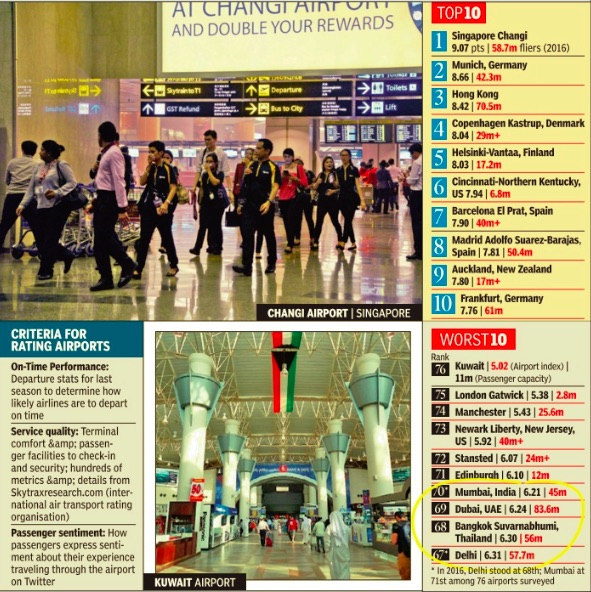
2018: Mumbai, Delhi, Hyderabad, Lucknow no.1 in their categories
March 7, 2018: The Times of India
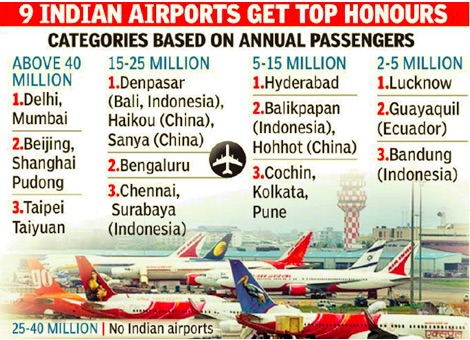
From: March 7, 2018: The Times of India
Mumbai, Delhi emerge as world’s best airports in global passenger survey
The next time you board a flight from Mumbai, do know you are stepping into the world’s best airport, according to Airports Council International (ACI), a trade association of 1,953 airports in 176 countries.
ACI announced its annual airport service quality (ASQ) awards on Tuesday and Mumbai tied with Delhi for the top position among airports handling over 40 million passengers annually. Beijing and Shanghai Pudong have been ranked second. With seven other airports making it to the top three (in various categories), India has the highest number of awards. China is second (six airports), followed by Indonesia (4).
“ASQ has statiscally validated the winners to ensure accuracy; as such, a tie indicates that no statistical difference has been found between the scores of two or more airports,” said ACI. The rankings are based on a survey that covers millions of passengers to collect feedback on 34 key performance indicators including airport access, checkin, security screening, restrooms, stores and restaurants. Within these, points were given for specifics like ground transportation to and fro airport, parking facilities, waiting time in check-in queue, efficiency of check-in, courtesy and helpfulness of airport staff, restaurant and eating facilities, value for money at these establishments, shopping facilities, value for money of shopping facilities, internet access, availability of and cleanliness of washrooms, cleanliness of terminal, ambience, arrival services like passport and customs inspection, speed of baggage delivery.
The Chhatrapati Shiva-ji International Airport operated and managed by GVK’s Mumbai International Airport Pvt Ltd (MIAL), and the Delhi airport, run by GMR, have also bagged the best airport award in the Asia Pacific region and in the combined category of region and size. In the 2016 ACI rankings, Mumbai along with Delhi and Singapore took the second rank in airports with over 40 million annual passengers category and those that fall in the Asia-Pacific region. Seoul Incheon took the first slot in both these categories.
Dr GVK Reddy, founder and chairman, GVK, said: “In 2007, when we had taken over the complete operations of the airport, the ASQ score was 3.53 and in 10 years we have got it to hover around 4.99 out of a maximum 5. It is a testimony to the quality service provided during 2017 to over 46 million travellers.”
Reaching the airport by road
The six metros compared
Jasjeev Gandhiok, Ride to airport slowest in Delhi among big 6, May 22, 2017: The Times of India
When it comes to reaching the airport by road, Delhi is ranked higher only than Chennai among the Metros. And despite the addition of several new airports across the country , accessibility remains a problem, a recent study by the School of Planning and Architecture has found.
At 29 kmhour by car and 24kmhour via public transport, Indian airports lag global standards (52kmhour and 64 kmhour, respectively) in terms of average journey speed.
The study , conducted by Amal Jose from SPA and titled Benchmarking of Accessibility and Connectivity of Indian Airports, analysed parameters such as air connectivity , ground accessibility, reliability , access travel time and speeds of the influenced networks.
Hyderabad ranks highest in terms of average journey speed in Metros to reach the airport with Delhi a lowly sixth. Overall, Delhi ranks 60th. Hyderabad averages a speed of 35.1kmhour, but people trying to reach the airport in Delhi can only manage an average speed of 20.1kmhour due bottlenecks on the way .
“As there are no benchmarking parameters for Indian airports, it is important that we fix these for improving the overall level of service. The government has announced different policies of UDAN to improve connectivity. A similar policy needs to be adopted to classify airports into different tiers, ranging from mega hubs -which will include Delhi and Mumbai -to Metro and regional hubs,“ said Sewa Ram, professor, Transport Planning at SPA.
According to the study , Delhi secured the fourth rank among Metros in terms of access by road, but an overall rank of 60 in terms of reliability. Shillong was first on the reliability index, followed by Aizawl and Goa. The study further pointed out that a journey from the city centre (Chandni Chowk) to the airport may take anywhere between 31 and 76 minutes in Delhi.
Runways near rivers
2005 & 2018 lessons
2005 & 2018 lessons: Airports near rivers prone to flooding, August 22, 2018: The Times of India

NDMA guidelines on urban flooding
From: 2005 & 2018 lessons: Airports near rivers prone to flooding, August 22, 2018: The Times of India
Course Of Water Bodies Altered To Create Infra
The flooding of Kochi airport in the past week is the latest example of the vulnerability of major Indian airports that have sprung up in the floodplains of rivers. That vulnerability could rise, say experts, as climate change is projected to increase extreme rainfall events.
Cochin International Airport (CIAL) is expected to remain shut until August 28. The prolonged closure echoes what happened in Mumbai in 2005 and Chennai in 2015 when those cities were hit by floods due to unprecedented rainfall. Both cities saw their airport runways closed and operations affected for weeks following the flood. The airports were not only built near rivers but had expanded their runways into the nearby rivers.
Kochi’s airport, built in the floodplains of the Periyar River, is relatively new. In the 1990s, “Kochi was at risk of falling off the aviation map entirely. Out of necessity, [the new airport] was founded on paddy fields and land that used to be part of the Chengal canal,” said a CIAL official.
Locals and activists blame the development for aggravating flooding in the area. “Every river has a floodplain that is supposed to hold the water, and this is an integral part of the river. In Kerala, these floodplains usually manifest as canals and ponds,” says local environmentalist C R Neelakandan.
CIAL managing director VJ Kurian, however, denied the airport had made the area flood-prone. Authorities did not build over the Chengal canal, he said, but diverted it to prevent flooding at the airport.
As Mumbai has seen, however, altering the course of a waterway can be disastrous. Both runways of the Mumbai airport were extended over the time across the adjacent Mithi River, squeezing the width of the channel. The second runway, built in the 1970s, created a right angle-bend in the river.
The airport’s expansion is widely held to have contributed to the 2005 floods, when the Mithi River overflowed after hours of intense rainfall. Airport authorities have since sought to mitigate the problem by doubling the width of the Mithi as well as dredging the riverbed to make it deeper.
Despite the 2005 experience, the Maharashtra government has decided to locate the region’s second airport near two rivers. Workers are already leveling a hill and diverting the Ulwe river for the Navi Mumbai airport. Officials say the Ulwe River’s mouth will be widened and the airport located above flood level. But surrounding villages are already complaining of more flooding.
In Chennai, too, the second runway was extended in 2011 across Adyar River on a bridge supported by closely-stacked pillars that block water flow. Although the airport has flood retaining walls and a raised runway, they were no proof against the water released from Chembaramkkam dam after the 2015 intense rainfall. Authorities have since widened part of the river and regularly desilt the channel near the bridge.
Why would anyone place a critical and expensive piece of infrastructure near a river? Probably because of the flat topography, says Kapil Gupta, professor of civil engineering at IIT-Bombay, who was consulted by the Mumbai airport after the 2005 floods. He notes that at least 4km of flat land is needed for a runway, apart from what is needed for the adjacent facilities. Plus, older airports like Mumbai and Chennai were small when they were first built several decades ago and would not have been so close to the river. As air traffic increased, planes became bigger, and the city developed around them, these airports have expanded toward the river.
Not every airport near a water body is vulnerable. Goa airport is a coastal one but is on a plateau with cliffs on two sides, deep storm water drains and the runways have water spilloff channels. Mysuru airport is near two lakes and a stream but it is upstream of the water bodies and is not so vulnerable.
The National Disaster Management Authority guidelines highlight the importance of airports in emergencies and recommend the provision of ample drainage and holding ponds. “Such ponds should be kept empty to absorb flood overflow,” said urban drainage expert Gupta, who had also recommended this measure to the Mumbai airport. Such holding ponds are present in Dulles airport in Washington DC as well as Heathrow in London.
With 100 new airports proposed, experts say it’s vital to plan them well. “Ideally, you should not have critical infrastructure in a floodplain, but if you do, you need to design it properly for drainage,” says Gupta. “You need to build infrastructure to survive at least a100-year-flood.”
(Inputs from Vikram Vinod, Vaishnavi Chandrashekhar, Newton Sequeira, Ganesh Lakshman, V Ayyapan, Shrinivasa M)
Runways, tricky
Srinagar, Leh, Port Blair, Kozhikode, Lakshadweep
Mangalore among six ‘tricky’ strips ON GROUND & IN AIR: FLYING INTO DISASTER
Anshul Dhamija | TNN
DANGER ZONES
Srinagar Leh Port Blair Kozhikode Lakshadweep
Mangalore: Mangalore’s Bajpe is a ‘special’ airport. Perched on a hillock, its runway is built on a flat stretch of land. Both ends of the runway, which has a mere 90-metre safety area against the 300-metre norm, slope downwards. That makes it tricky for pilots.
If a pilot misjudges landing or take-off, the aircraft will overshoot the runway and go downhill. That is what seems to have happened on Saturday.
Besides Mangalore, there are several other airports that come with a ‘special tag’ due to peculiarities and complexities involved in the landing and take-off procedures. Typically, airports located in hilly and mountainous regions, and those adjacent to water bodies like rivers and seas are classified as ‘special’. They include airports at Srinagar, Leh, Port Blair, Kozhikode and Agatti (Lakshadweep). The Vizag airport used to be on this list until a new airport was built.
“The runways at the airports in Leh and Port Blair are unidirectional, which means aircraft can only land and take off in one direction irrespective of the direction of the wind. That’s because both have mountainous terrain on one side of the runway,’’ says a former IAF pilot. Only experienced pilots can fly to special airports
Mangalore: Airports located in hilly terrain, such as Mangalore’s Bajpe and others, often get a ‘special tag’ due to complexities involved in landing and take-off. ‘‘At the Calicut airport, pilots have to keep a close watch on the hills close by. At Agatti, the runway is very small, with tall trees on one side of the airport. At Srinagar airport, the winds are of high speed and the topography mountainous,’’ says a pilot, who flies for a leading airline in India.
Only very experienced pilots and co-pilots are deployed to fly aircraft to special airports. According to airline officials, pilots operating to these airports undergo special training, and are constantly put through special checks.
Mangalore, Patna
Table-tops, bird hits: Many tricky runways in India TIMES NEWS NETWORK
New Delhi: The Air India Express Boeing that crashed in Mangalore on Saturday veered off the runway after missing the landing threshold — an error that rarely causes a crash. In this case it did because of the runway’s unusual configuration. The airstrip sits on a plateau making landing a test of any pilot’s skill. But Mangalore’s Bajpe airport isn’t the only tricky one in the country and experts warn that more such disasters are waiting to happen if the burgeoning aviation sector doesn’t keep pace with safety norms.
Particularly, the Kozhikode international airport in Kerala, with its table-top runway, comes under the scanner. A flight overshot the runway recently but the pilot was able to halt the aircraft preventing a disaster.
The Kozhikode airport has a 2,860 m long runway surrounded by hillocks. There’s a valley at the end of the runway as in Mangalore. Experts have long demanded a 12,000 ft extension apart from an additional ILS. But this hasn’t materialized. ‘‘A table-top runway is the only option, given the terrain,’’ said airport director G Chandramouli.
Up north in Bihar, Mangalore is waiting to happen at Patna with only 6,330 ft of the 7,500 ft runway available for landing. Because of this, airlines don’t operate with full load, particularly in summer. Bigger aircraft just can’t operate here. A disaster here would be much worse than Mangalore because if an aircraft overshoots the runway, it will crash into human settlements. Also, the Patna-Delhi railway track lies parallel to the airport’s boundary wall.
A decade-and-half after the first international flight took off from Jaipur, the city’s Sanganer airport continues to operate on International Civil Aviation Organization’s provisional licence due to non-compliance with norms. The organization is concerned about the airport’s proximity to residential areas.
Chandigarh international airport lacks adequate facilities and falls short of safety norms with no night landing facility. Ahmedabad’s Sardar Vallabhbhai Patel international airport, with 80 flights and an average of 5,475 passengers daily, is one of the busiest in the country. It reports the highest bird hits in the country mainly due to slums and the vegetation around it, forcing the authorities to install laser guns to scare away birds. In 2009, it reported 24 bird hits. Along with bird hits, Nagpur airport has often been in the news for ‘‘animal hits’’ due to its proximity with monkey and deer habitat.
Potential Disasters?
Kozhikode International Airport Patna Airport Sanganer Airport, Jaipur Chandigarh International Airport Sardar Vallabhbhai Patel International Airport, Ahmedabad Nagpur Airport
Chamundi Hills, in the vicinity of Mysore airport, is not in the aircraft’s approach path, but concerns have cropped up now
Runways, tricky III Patna and Jammu
Patna and Jammu runways most critical: Aviation min Saurabh Sinha | TNN
New Delhi: Patna and Jammu, both nightmarish landing strips for pilots, have emerged as the most critical among 11 airports in an evaluation by the aviation ministry in the aftermath of the Mangalore crash last month. The runway in both these busy airports is shorter than Mangalore’s (8,000ft), with no room for error or emergency.
The Patna strip runway is so constrained that authorities fear a Mangalore-like situation could mean the plane breaching the boundary wall and ramming a train as a railway line is just beyond the 6,000ft runway. The aviation ministry is set to ask the Bihar government to act fast on its advice to shift the airport.
Jammu has a longer runway, at 6,700 feet, but aircraft have to apply screeching brakes as they negotiate a sharp turn on approach. A longer turn could mean entering Pakistani airspace just 6 nautical miles away.
Even Riskier Than Mangalore?
Patna’s runway is just 6,000ft long (Mangalore was 8,000ft long). Tall trees of a botanical garden on one side and a railway line where the runway ends. No scope to extend runway Jammu runway is 6,700ft long. Difficult, sharp-turn approach to runway means planes have to apply screeching brakes on landing
Armed forces opposed to extending Jammu runway to 8,000ft Politics roadblock to alternative airport at Patna?
New Delhi: Post-Mangalore crash, the aviation ministry has identified 11 airports where the Directorate General of Civil Aviation (DGCA) had sent teams for inspection as critical. These airports are: Leh, Kullu, Shimla, Port Blair, Agartala, Lengpui, Calicut, Mangalore, Latur, Jammu and Patna — the last two the most critical.
Most of these airports are situated in difficult terrain where extending the runway is next to impossible. In Kullu, for instance, the river Beas flows on both ends of the runway. The only way to extend the airstrip is to build a bridge on the river and link it to the airstrip.
Almost a week after the list was prepared for priority inspection, a top official said: “In other places, certain safety augmentation measures can be taken but those two cities don’t offer much scope. Patna airport has a botanical garden with high trees on approach and a railway line on the other end of runway. Trees can’t be cut and the railway line can’t be shifted. As a result, planes have to land in the 6,000-feet available with no room for error. The state government has been asked to shift the Patna airport for a while now.”
The site identified for the alternate airport is Bitah, an existing defence airport that sees one or two flights a week.
Sources said the state’s delay in shifting the airport is due to political considerations — a section of the ruling party is known to favour a top state leader’s constituency as the location for the new airport.
Safety
2015-16: ‘near-misses’
The Times of India, May 09 2016
Delhi, Mumbai, Chennai airspaces see 26 near-misses
Chethan Kumar
On March 29, 2016, passengers aboard SpiceJet 614 and Air Mauritius flight 746 deplaned and streamed out of the airport, oblivious that the two aircraft had a near-miss, a narrowly avoided collision, in the Chennai International Airport airspace.
During June 2015 and May 2016, there have been 35 such near-misses. All these cases have occurred in just eight airport airspaces, including one in Jammu's IAF-controlled airport, information reveals. Delhi, Chennai and Mumbai airspaces account for 26 incidents. Not a single near-miss was reported from Kempegowda International Airport, Bengaluru.
If the latest incident in Chennai saw a SpiceJet flight come in close proximity with the landing Mauritius Airlines aircraft, the one on March 3, 2015 in Delhi was a result of an aircraft picking up a command meant for another aircraft and acting on it.
From miscommunication to wrong instructions, there have been varied rea sons for such near-mishaps.
In another incident on March 10, 2015 in Chennai, the controller had assigned a “wrong left turn to Jet Airways flight 2764“. Corrective action was taken to avoid the aircraft from running into a SriLankan Airlines flight.
Aviation regulator DGCA, which reviews these investigations, has considered them serious. From proficiency checks for pilots and air traffic controllers to circulars issued to change confusing call-signs, the DGCA has put in place 11steps.
Small airports: Poor visibility
Poor visibility at small airports a worry
V Ayyappan | TNN
Chennai: Though visibility is a crucial factor for pilots to make a safe landing, most of the small airports in the south do not have modern equipment to measure runway visibility and feed it to the air traffic control system.
With rains round the corner in the west coast, accurate information about the extent of visibility at airports in Thiruvananthapuram, Kochi, Kozhikode, Mangalore and Coimbatore is vital for pilots.
At the Chennai airport that handles up to 400 flights every day, there is only one transmissometer — used to gauge runway visibility range (RVR) — installed near the touchdown point at the Pallavaram end of the main (07) runway. The other end of the runway does not have the equipment.
‘‘A transmissometer would have helped the pilot of the ill-fated Air India Express flight at Mangalore. Readings of dew point and temperatures were indicating that air was less dense, which means the aircraft may have needed more landing run, said V Krishnan, a former office-bearer of Air Traffic Controllers Guild.
International Civil Aviation Organisation (ICAO) recommends RVR for runways served by Instrument Landing System (ILS). And almost all airports have ILS, still they do not have transmissometers, he added.
The meteorological department has chosen to install the equipment at airports where they have a forecasting office instead of looking at the requirement of pilots. Here too, only one end of the runway has transmissometers.
When transmissometers are not installed, the Met department issue does a manual calculation by measuring the lowest distance from where an object could be spotted at a 360 degree angle.
Though plans to install more such transmissometres were drawn up two years ago, fund crunch had slowed down the installation. Met department hopes that the Mangalore disaster would speed up the process.
Indian operators at foreign airports
The Bureau of Civil Aviation Security (BCAS) is the regulator for civil aviation security in the country and is responsible for laying down the standards for embarkation security and anti-sabotage measures in respect of civil flights and ensuring their compliance through regular Inspections and Security Audits. The aim of BCAS is to safeguard Civil Aviation operations against acts of unlawful interference and it is the regulatory authority for discharging all relevant national and international obligations in respect of training of personnel in aviation security responsibilities which include, inter alia, planning and co-ordination of all aviation security related activities, operational emergencies and crisis management. The Commissioner of Security (CA), BCAS is the "Appropriate Authority" to ensure development, maintenance, updating and implementation of National Aviation Security Programme for India and to fulfill all international obligations in this context.
The BCAS has its headquarters in New Delhi and 4 Regional Offices located at Delhi, Mumbai, Kolkata and Chennai airport, each under a Deputy Commissioner of Security (CA), regulating, monitoring and conjecturing regular security Inspections and audits of the airports in Northern, Eastern, Western and Southern region, respectively.
A proposal for restructuring/strengthening the BCAS has since been approved by the Government of India which involves establishing of four additional Regional at Amritsar, Guwahati, Hyderabad and Ahmedabad, each headed by a Deputy Commissioner of Security. The Four existing Regional offices at the Metros, viz., Delhi, Mumbai, Chennai and Kolkata will be upgraded and headed by an officer of the level of Senior Deputy Commissioner of Security. Besides this, 69 additional posts have been created at various levels to strengthen the existing infrastructure.
Further, one post of Joint Commissioner of Security (CA) of the rank of inspector General of Police has also been created to strengthen the senior management level at the BCAS Headquarters.
AIRPORTS AUTHORITY OF INDIA
Airports Authority of India (AAI) is a leader PSU under the Ministry of Civil Aviation engaged in development, building airport infrastructure & managing airports across the length and breadth of the country including remote and far flung areas. AAI came into existence on 01.04.1995 with the merger of the then two authorities (National Airports Authority & International Airports Authority of India). AAI manages 115 airports including 23 civil enclave and also provides CNS-ATM facilities at 11 other airports. AAI has been bestowed with the responsibility to manage the entire Indian airspace measuring around 2.8 million nautical square mile area covering the Bay of Bengal and the Arabian Sea, as designated by ICAO for provisioning of Air Traffic Services in the said air space.
Land assets
Airports can exploit huge land assets to fly high, Feb 2, 2017: The Times of India
Finance minister Arun Jaitley's Budget cleared the way to amend the AAI Act “to enable effective monetisation of land assets“. “The resources, so raised, will be utilised for airport upgradation,“ the FM said. He also allowed private sector participation in operating and maintaining airports in small towns, as in their metro counterparts.
The Modi government estimates that developing airports across India over the next 15 years will require an investment of Rs 2-3 lakh crore, minus the cost of land. AAI has a huge land bank of 55,687 acres across the country -collectively one-and-a-half times the size of Chandigarh.
However, the AAI Act currently allows using this land only for aviation-related activities. “(With cities expanding) AAI airports are now in the middle of most cities. The demand for use of our land is for things like malls and convention centres, which the Act does not allow at present.
Globally , due to efficient land use, airports are able to generate almost 40 45% of their total revenue through nonaeronautical uses. “Our non-aero revenue accounts for 20-25% of the total generation. We will be able to increase that and bring it on a par with global standards with the change,“ Mohapatra said.
But commercial exploitation of land at sensitive airports like Srinagar or Jammu and civil enclaves -which means airports managed by defence au thorities with a terminal for commercial flights, like Agra and Jodhpur -may not be easy .
Development of Airport Infrastructure-Status Thereof
As is known, AAI had embarked upon a laudable plan of moderning and upgrading its airports due to the influx of air traffic in the past decade. AAI had dual aim. Firstly to match/keep pace ahead of the increase in the density, both of aircraft & air populace and secondly, to provide the country with world-class standard airports. Accordingly, 60 airports inclusive of Kolkata and Chennai airports were identified for modernization and upgradation, rationale being to develop the State Capitals and other airports which have the potential to attract the tourist and business travellers who would meaningfully contribute towards the economic growth of the state.
The task involved being humongous and cost intensive, the magnitude can be well gauged from the fact that the capital outlay in the 10th Five Year Plan was R 3534 crores wheareas in the 11th Five Year Plan it was R 12964 crores, an increase of almost 300 per cent, modernization of Kolkata and Chennai Airports being to the tune of 4340 crores (2325 crores Kolkata & 2014 crores Chennai). Most of the airport infrastructure projects initiated have since been completed or are near completion and thus making AAI stand in good stead, as the facilities provided are not only user-friendly but also of world-class standard based on the latest state-of-the art technology. However, to be more specific, appended below are the details:-
Projects Completed
Amritsar, Dehradun, Jaipur, Kullu, Srinagar, Udaipur, Varanasi, Gaya, Cooch Behar, Agartala, Barapani (Shillong), Dibrugarh, Lilabari, Ahmedabad, Aurangabad, Bhopal, Nagpur, Pune, Surat, Calicut, Madurai, Mangalore, Mysore, Trichy Trivandrum, Vizag, Chandigarh and Godia airports.
Projects near Completion
Lucknow, Khajuraho, Ranchi, Vadodra, Jaisalmair, Bhubaneswar, Raipur, Goa, Indore, and Rajahmundri Airports. Projects on the anvil Portblair, Jammu, Coimbatore, Puducherry and Tirupati.
DELHI, MUMBAI AIRPORTS: RESTRUCTURING
Modernization of Delhi Airport : The Operation, Management and Development Agreement (OMDA) was signed between M/s Delhi International Airport Pvt, Ltd. (DIAL) and Airports Authority of India (AAI) on 04.04.2006. The lease of the Airport to the Joint Venture Company is for an initial period of 30 years, which is extendable by another 30 years. Subsequent to the signing of OMDA, DIAL took over IGI Airport on 3rd May 2006.
DIAL had prepared a 20 year Master Plan for restructuring and development of IGI Airport, projecting all the facilities which will be commissioned in a phased manner and would ultimately cater to 100 million passengers by 2036. With the completion of Phase-I work of IGIA in 2010, a new integrated Terminal-3 has become operational with 34 million passenger handling capacity per annum, covering both international and domestic passengers, 168 check-in counters, 24 remote check-in counters, most modern 5 level in-line baggage system, 98 immigration counters, 78 aero bridges, multi-level car parking (4300 cars capacity), 3000 CCTV, 352 Screening machines, etc. IGIA has been rated as 4th in the category of 25-40 million passengers per annum (mppa).
Modernization of Mumbai Airport
The OMDA was signed between Mumbai International Airport Pvt. Ltd. (MIAL) and AAI on 4th April, 2006, and the latter took over the management and development of Chhatrapati Shiva ji International Airport (CSIA) w.e.f. 3rd May, 2006. There was a transition phase of three months and w.e.f 3rd August, 2006, MIAL has been independently handling management and operations of CSIA. As per the Master Plan prepared by MIAL, total project cost for development of CSIA is estimated to be Rs.9802 crore. The target date for completion of this project is 31.12.2012. The major development works completed during the Year 2010-11 are S6 (Realignment of Taxiway B1 to Code F), S09 1108 India 2012 (Completion of South-West pier) projects, Apron T2, Upgradation and Realignment of Runway 09/27, Relocation of Various Facilities, integrated passenger terminal/ car park/Sahar Access Road, Other Projects etc. CSIA, Mumbai has emerged as one of the top performing airports and has been rated the 2nd best airport worldwide by ACI in the 15-25 mppa.
GREENFIELD AIRPORTS
Bengaluru International Airport, Devanahalli, Bengaluru : A Greenfield airport project at Devanahalli near Bengaluru has been implemented on a Build Own Operate and Transfer (BOOT) basis for 30 years with Public-Private-Participation (PPP) at a revised cost of Rs.2068 crore. Government of Karnataka and AAI together hold 26% equity and the strategic joint venture partners hold the balance 74%. AAI's investment in the equity is capped at Rs.50 crore. A Consortium led by Siemens, Germany with Unique Zurich, Switzerland and Larsen and Toubro, India Limited, as other members have been chosen as the strategic Joint Venture Partners. The airport was commissioned on 24 May, 2008.
International Airport, Hyderabad
Rajiv Gandhi International Airport, Shamshabad, Hyderabad
A Greenfield
airport has been developed in Shamshabad, near Hyderabad on Build Own Operate and Transfer (BOOT) basis with PPP by the Government of Andhra Pradesh. The approximate cost of the Project is Rs.2920 crore. AAI and Government of Andhra Pradesh together hold 26% equity with AAI's equity being capped at Rs.500 million.
The balance 74 per cent is being held by the strategic partner, a consortium consisting of M/s GMR Enterprises and Malaysian Airports Holdings Berhand (MAHB). The airport was commissioned on 23 March, 2008.
It is worth mentioning that Airports Council International has adjudged Rajiv Gandhi International Airport, Shamshabad near Hyderabad as the 'World's Best Airport' for the airport service quality amongst the airports handling 5-15 million passengers, category for the year 2009.
Policy for Greenfield Airports
The Government has promulgated the Policy for Greenfield Airports on 24.04.2008. The new policy aims to streamline the approval process to facilitate strengthening and augmenting of airports infrastructure in the country. It also attempts to make the approval process more transparent and predictable. The policy does not attempt to undermine the authority of the Government/Union Cabinet. Pursuant to Policy for Greenfield Airports, a Steering Committee was constituted to monitor and facilitate the approval process of proposals received for setting up of the airport.
So far, the Central Government had accorded "in-principle" approval for setting up of a Greenfield airport at Mopa (Goa), Navi Mumbai, Sindhudurg (Maharastra), Bijapur, Gulbarga, Hassan, Simoga (Karnataka), Kannur (Kerala), Pakyong (Sikkim), Durgapur (West Bengal), Dabra (Madhya Pradesh), Palladi (Rajasthan), Kushinagar (Uttar Pradesh), Karaikal (Puducherry) and Shirdi (Maharashtra).
Airport Economic Regulatory Authority (AERA)
AERA has been established on 12.05.2009 with the prime objective to create a level playing field and foster healthy competition among all major airports (Government owned, Public Partnership based, Private), encourage investment in airport facilities, regulate tariffs of aeronautical services, protection of reasonable interest of users, operate efficient, economic and viable airports at notified airports. The commencement of chapter III and chapter VI of AERA is notified, w.e.f. 01 .09.2009
to enable AERA to discharge regulatory functions. AERA has got operationalized with manpower consisting of Chairperson, Secretary and other skeleton supporting staff. The AERA is in the process of formulating approach, philosophy in economic regulation of airports and air navigation services for regulation of tariff in consultation with stakeholders.
Mumbai airport
2015, capacity
Manju V
May 18, 2015
Mumbai airport handles record 851 flights in a day
Surge in flights out of Mumbai airport
The congested Mumbai airport which uses only a single runway at a time for flight operations handled a total of 851 flight movements on May 15, 2015. For a while now, the airport has been handling record number of flights on particular days. Prior to this, in February 2015, the airport handled 840 takeoffs and landings in a day as there was a sudden rise in number of charter flights operated out of the city as politicians thronged Anjani village to attend former deputy chief minister R R Patil's funeral.
The sudden increase in flight movements was caused by an increase in charter aircraft operations. On an average, other than the passenger flights, the airport handles about 30-40 charter flights a day. But on certain days, the number of charter flights jumped. Apart from the scheduled flights, the airport handled 50 charter flights and 24 freighter flights. The Mumbai airport has been working towards reducing Runway Occupancy Time (ROT) for aircraft so that more operations can be handled in an hour.
However the extra load was not handled during peak traffic time. That is because charter flight operations are banned from 8 am to 10 am and 5 pm to 7 pm. The waiting time to take off or land on Mumbai airport's runways may be long in the morning and evenings, but the scene is different in the afternoons when the flight movements are low and flights depart more or less on-time, except on days when there are problems like weather-related delays.
Mumbai, busiest in 2017
Manju V , Mumbai world's busiest airport with only one runway , May 13, 2017: The Times of India
HIGHLIGHTS
No other major city in the world is serviced by a lone airport that has a single operational runway.
All passenger and cargo aircraft operate from a single runway at Mumbai airport.
Main airports of most major cities such as Delhi, Dubai, Singapore, Sydney handle aircraft with at least two parallel runways in use.
Mumbai airport quietly overtook London's Gatwick to become the world's busiest airport that operates with a single runway.
For the airport operator and Mumbai air traffic control, it's an achievement. They now handle one of the most difficult jobs in the world, as every 65 seconds an aircraft either takes off from or touches down at the Mumbai airport.
For the government, though, it would be a matter of shame as no other major city in the world is serviced by a lone airport that has a single operational runway. The main airports of most major cities such as Delhi, Dubai, Singapore, Sydney, London and New York handle aircraft with at least two parallel runways in use.
All passenger and cargo aircraft operate from a single runway — either the main runway (0927) or, when it's shut for repairs, the secondary one (1432).
In the financial year ending March 2017, Mumbai airport handled 45.2 million passengers, beating Gatwick's 44 million. "Currently, Mumbai airport handles 837 arrivals or take-offs in a day — an average of 80 flights more than Gatwick, which handles 757 movements in a day," said an airport official. A senior air traffic controller, while requesting anonymity, said, "We position two arrivals every 130 seconds and one departure in between these two arrivals. So there is one take-off or touch-down every 65 seconds from the main runway of Mumbai airport."
What makes the job tough is when flight operations have to be moved to the less efficient secondary runway. For instance, between February and April 2017, from 9am to 5pm, flight operations were moved to the secondary runway as the main one was taken up for maintenance work.
"We broke Gatwick's record in such conditions. It shows the level of perfection air traffic controllers in Mumbai have achieved through rigorous training," he added. Though Mumbai airport has two cross runways, only one is in use at any given time, making Mumbai an accidental entrant into the group of airports around the world that operate with a lone runway. It's not an unjust inclusion, as other airports in the single runway league, like Gatwick, for instance, have similar arrangements. Gatwick has two parallel runways but uses only one at a time. "Because of land constraints, Mumbai airport cannot have a parallel runway and simultaneous use of its cross runways is too complicated, which leaves the lone runway to handle all air traffic," said the air traffic controller.
Mumbai International Airport Pvt Ltd (MIAL), the company that runs the airport, has been working at improving the taxiway network of the airport. The less time an aircraft spends on the runway to take off or land, more the number of flights it can handle.
"Currently, work on extension of an existing taxiway is on to connect the Terminal 2 aircraft parking apron to runway 27. It will provide the much-required additional holding area for aircraft ready to take off on the main runway 27," said an MIAL spokesperson.
2018: a record 1,000 flights in a day
When Air France flight AF 218 landed in Mumbai on Tuesday at 11.54 pm, it created history for Chhatrapati Shiva-ji International Airport (CSIA) by becoming this old aviation hub’s first ever 1000th flight in a day. The big storm that swept Mumbai late on Monday night saw over 25 incoming flights being diverted to other cities. Once the weather improved around Monday-Tuesday midnight, they started taking off for Mumbai and this “spill over” saw CSIA clocking up 1,003 flight movements on Tuesday. IndiGo’s flight from Kolkata (6E-961), which touched down there at 11.58 pm, was the last flight of that super busy day.
The previous record for the airport was 988 flight movements on May 19, which was an improvement over 980 flights witnessed on February 10. The average daily flight movement is 950.
Traffic handled at airports
2016/ IGI airport crossed 5 crore passenger mark
Saurabh Sinha, IGI first in India to cross 5cr flyer mark, Feb 5, 2017: The Times of India
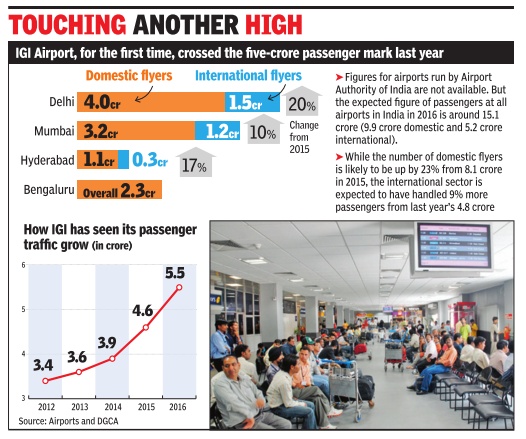
In a first for any Indian airport, IGI Airport crossed the 5-crore passenger mark in 2016.
The airport with three runways and as many terminals handled 5.5 crore passengers: 4 crore domestic and 1.5 crore international flyers. Mumbai was a distant second at 4.4 crore.
This was 21% higher than 4.6 crore passengers IGI had handled in 2015, according to figures furnished by the Delhi International Airport Pvt Ltd (DIAL).
Delhi's record comes at a time when the country set new highs for both domestic and international air travel last year, primarily because of low international oil prices that allowed airlines to offer cheap fares. Almost 10 crore domestic passengers flew in India in 2016, up 23% from 2015's figure of 8.1 crore. The number of international flyers last year is likely to be over 5.2 crore, up almost 9% from the previous year's 4.8 crore.
India's international flyers generally grow at 10% year-on-year while domestic travellers, dependent on oil prices that determine airfares, has grown at over 20% in the recent past.
With Delhi and Mumbai alone accounting for almost 10 crore of the total (domes tic-cum-international) traffic that is expected to be just over 15 crore in 2016, the two mega cities account for twothird of entire air traffic in India. But with both these places facing challenges Mumbai is majorly low on airport capacity while Delhi is seeing bottlenecks at its domestic budget terminal -the growth is bringing its own challenges.
Successive Union governments have been talking of clearing a second airport for Delhi, but there has been no concrete move on that front. The aviation ministry last year approved a revised master plan for IGIA under which it will get a bigger budget terminal; a new one and the fourth runway . However, DIAL has so far neither shared the details of that plan, nor given a timeline and cost estimate for executing the expansion work.
“IGI has huge tracts of open land where more terminals and another runway can be built. The problem area is Mumbai. Navi Mumbai is a very challenging site where hills have to be levelled and rivulets diverted.But apart from that site, there is no other place of that size available that can house Mumbai's second airport,“ said a source.
Traffic at International Airports
2013-14
Jan 15, 2015 The Times of India
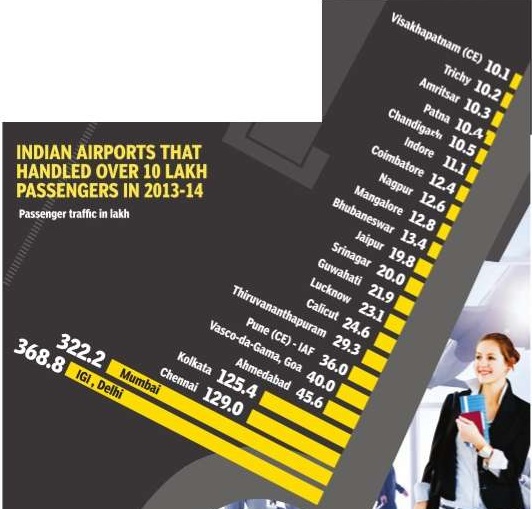
Unsuccessful airports
The Times of India, Aug 20 2015
Ghost airports bear witness not all projects soar
Two-and-a-half years after the completion of a new $17 million terminal building, the airport in Jaisalmer, stands empty . Not a single passenger has passed through the gates of the airport in Rajasthan, big enough to handle more than 300,000 travellers a year, with parking bays for three 180seater narrow-body jets.
India has spent more than $50 million since 2009 on eight airports that do not receive scheduled flights -white elephants that are a reminder of the pitfalls for PM Narendra Modi as he bets on an infrastructure drive to fuel growth.
India's main hubs, mean while, are bursting at the seams, slowing airlines' ability to expand in a vast country where they should be supporting economic growth.
“They (the government) need to realise it's not a case of `build the airport and we will come',“ said Sanjiv Kapoor, chief operating officer at SpiceJet. The airline last year ceased flying to a new airport in Mysore because of insufficient demand.
See also
Airports: India
